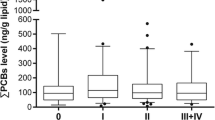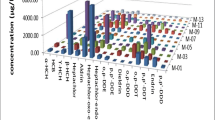Abstract
We determined the concentrations of 98 halogenated organic compounds and synthetic musks in breast fat tissues of 50 breast cancer patients (age range: 34–77 years) collected during 1996–1998 in Ulster County, New York, USA. Polychlorinated biphenyls (PCBs), organochlorine pesticides (OCPs), polybrominated biphenyl 153 (PBB-153), polybrominated diphenyl ethers (PBDEs), and synthetic musk compounds (SMCs) were analyzed in breast fat tissues, and 46 analytes were found at a detection frequency of ≥ 65% and at concentrations in the decreasing order of OCPs > PCBs > SMCs > PBDEs > PBB-153. PCBs (median: 323 ng/g wet wt) and dichlorodiphenyltrichloroethanes (DDTs, median: 293 ng/g wet wt) were the major compounds found in breast fat tissues. Among PCB congeners, hexa- and hepta-chlorobiphenyls (60% of total PCBs) were the abundant ones. p,p′-DDE accounted for more than 99% of the total DDT concentrations. The concentrations of SMCs and PBDEs were 1–2 orders of magnitude lower than those of PCBs and DDTs. 1,3,4,6,7,8-Hexahydro-4,6,6,7,8,8-hexamethylcyclopenta-r-2-benzopyran (median: 33 ng/g wet wt) was the most abundant SMC, whereas BDE-47 (median: 4.5 ng/g wet wt) was the most dominant PBDE congener present in breast tissues. A significant correlation (p < 0.05) between women’s age and concentrations of DDTs, chlordanes, hexachlorobenzene and PCBs in breast tissues was found. Concentrations of PCBs, PBDEs, OCPs, and SMCs were not significantly different between malignant and benign tumor cases. This study adds baseline information on target tissue burdens of persistent organic contaminants in breast cancer patients.
Graphical Abstract



Similar content being viewed by others
References
Achour A, Derouiche A, Barhoumi B et al (2017) Organochlorine pesticides and polychlorinated biphenyls in human adipose tissue from northern Tunisia: current extent of contamination and contributions of socio-demographic characteristics and dietary habits. Environ Res 156:635–643
Arrebola JP, Cuellar M, Claure E et al (2012) Concentrations of organochlorine pesticides and polychlorinated biphenyls in human serum and adipose tissue from Bolivia. Environ Res 112:40–47
Artacho-Cordón F, Fernández-Rodríguez M, Garde C et al (2015) Serum and adipose tissue as matrices for assessment of exposure to persistent organic pollutants in breast cancer patients. Environ Res 142:633–643
Artacho-Cordón F, León J, Sáenz JM et al (2016) Contribution of persistent organic pollutant exposure to the adipose tissue oxidative microenvironment in an adult cohort: a multipollutant approach. Environ Sci Technol 50(24):13529–13538
Batt AL, Wathen JB, Lazorchak JM (2017) Statistical survey of persistent organic pollutants: risk estimations to humans and wildlife through consumption of fish from U.S. rivers. Environ Sci Technol 51(5):3021–3031
BCS (2018) U.S. Breast Cancer Statistics (BCS). https://www.breastcancer.org/symptoms/understand_bc/statistics. Accessed 24 Nov 2018
Bramwell L, Glinianaia SV, Rankin J et al (2016) Associations between human exposure to polybrominated diphenyl ether flame retardants via diet and indoor dust, and internal dose: a systematic review. Environ Int 92–93:680–694
Bray F, Ferlay J, Soerjomataram I et al (2018) Global cancer statistics 2018: GLOBOCAN estimates of incidence and mortality worldwide for 36 cancers in 185 countries. CA Cancer J Clin 68(6):394–424
Çok I, Durmaz TC, Durmaz E, Satıroglu MH, Kabukcu C (2010) Determination of organochlorine pesticide and polychlorinated biphenyl levels in adipose tissue of infertile men. Environ Monit Assess 162(1–4):301–309
Covaci A, Voorspoels S, Roosens L (2008) Polybrominated diphenyl ethers (PBDEs) and polychlorinated biphenyls (PCBs) in human liver and adipose tissue samples from Belgium. Chemosphere 73(2):170–175
De Saeger S, Sergeant H, Piette M, Bruneel N, Van de Voorde W, Van Peteghem C (2005) Monitoring of polychlorinated biphenyls in Belgian human adipose tissue samples. Chemosphere 58(7):953–960
Engmann NJ, Golmakani MK, Miglioretti DL, Breast Cancer Surveillance Consortium (2017) Population-attributable risk proportion of clinical risk factors for breast cancer. JAMA Oncol 3(9):1228–1236
Fernandez MF, Araque P, Kiviranta H, Molina-Molina JM, Rantakokko P, Laine O, Vartiainen T, Olea N (2007) PBDEs and PBBs in the adipose tissue of women from Spain. Chemosphere 66(2):377–383
Fernandez MF, Kiviranta H, Molina-Molina JM, Laine O, Lopez-Espinosa MJ, Vartiainen T, Olea N (2008) Polychlorinated biphenyls (PCBs) and hydroxy-PCBs in adipose tissue of women in Southeast Spain. Chemosphere 71(6):1196–1205
Gasull M, Bosch de Basea M, Puigdomènech E et al (2011) Empirical analyses of the influence of diet on human concentrations of persistent organic pollutants: a systematic review of all studies conducted in Spain. Environ Int 37(7):1226–1235
Golden R, Kimbrough R (2009) Weight of evidence evaluation of potential human cancer risks from exposure to polychlorinated biphenyls: an update based on studies published since 2003. Crit Rev Toxicol 39(4):299–331
Gump BB, Yun S, Kannan K (2014) Polybrominated diphenyl ether (PBDE) exposure in children: possible associations with cardiovascular and psychological functions. Environ Res 132:244–250
Harrad S, De Wit CA, Abdallah MAE et al (2010) Indoor contamination with hexabromocyclododecanes, polybrominated diphenyl ethers, and perfluoroalkyl compounds: an import exposure pathway for people? Environ Sci Technol 44:3221–3231
He Y, Peng L, Zhang W et al (2018) Adipose tissue levels of polybrominated diphenyl ethers and breast cancer risk in Chinese women: a case-control study. Environ Res 167:160–168
Johnson-Restrepo B, Kannan K, Rapaport DP, Rodan BD (2005) Polybrominated diphenyl ethers and polychlorinated biphenyls in human adipose tissue from New York. Environ Sci Technol 39:5177–5182
Kalantzi OI, Brown FR, Caleffi M et al (2009) Polybrominated diphenyl ethers and polychlorinated biphenyls in human breast adipose samples from Brazil. Environ Int 35(1):113–117
Kannan K, Reiner JL, Yun SH et al (2005) Polycyclic musk compounds in higher trophic level aquatic organisms and humans from the United States. Chemosphere 61(5):693–700
Kiviranta H, Tuomisto JT, Tuomisto J, Tukiainen E, Vartiainen T (2005) Polychlorinated dibenzo-p-dioxins, dibenzofurans, and biphenyls in the general population in Finland. Chemosphere 60(7):854–869
Kunisue T, Takayanagi N, Isobe T et al (2007) Polybrominated diphenyl ethers and persistent organochlorines in Japanese human adipose tissues. Environ Int 33(8):1048–1056
Lee DH, Jacobs DR Jr, Park HY, Carpenter DO (2017) A role of low dose chemical mixtures in adipose tissue in carcinogenesis. Environ Int 108:170–175
Leng L, Li J, Luo X et al (2016) Polychlorinated biphenyls and breast cancer: a congener-specific meta-analysis. Environ Int 88:133–141
Li AJ, Xue J, Lin S et al (2018) Urinary concentrations of environmental phenols and their association with type 2 diabetes in a population in Jeddah, Saudi Arabia. Environ Res 166:544–552
Lichtenstein P, Holm NV, Verkasalo PK et al (2000) Environmental and heritable factors in the causation of cancer. N Engl J Med 343:44–85
Malarvannan G, Dirinck E, Dirtu AC et al (2013) Distribution of persistent organic pollutants in two different fat compartments from obese individuals. Environ Int 55:33–42
Moon HB, Lee DH, Lee YS et al (2012a) Polybrominated diphenyl ethers, polychlorinated biphenyls, and organochlorine pesticides in adipose tissues of Korean women. Arch Environ Contam Toxicol 62(1):176–184
Moon HB, Lee DH, Lee YS, Kannan K (2012b) Occurrence and accumulation patterns of polycyclic aromatic hydrocarbons and synthetic musk compounds in adipose tissues of Korean females. Chemosphere 86(5):485–490
Mustieles V, Fernández MF, Martin-Olmedo P et al (2017) Human adipose tissue levels of persistent organic pollutants and metabolic syndrome components: combining a cross-sectional with a 10-year longitudinal study using a multi-pollutant approach. Environ Int 104:48–57
Naert C, Piette M, Bruneel N, Van Peteghem C (2006) Occurrence of polychlorinated biphenyls and polybrominated diphenyl ethers in Belgian human adipose tissue samples. Arch Environ Contam Toxicol 50(2):290–296
Nakata H, Kawazoe M, Arizono K et al (2002) Organochlorine pesticides and polychlorinated biphenyl residues in foodstuffs and human tissues from China: status of contamination, historical trend, and human dietary exposure. Arch Environ Contam Toxicol 43(4):473–480
Nakata H, Hinosaka M, Yanagimoto H (2015) Macrocyclic-, polycyclic-, and nitro musks in cosmetics, household commodities and indoor dusts collected from Japan: implications for their human exposure. Ecotoxicol Environ Saf 111:248–255
Pauwels A, Covaci A, Weyler J, Delbeke L, Dhont M, De Sutter P, D’Hooghe T, Schepens PJC (2000) Comparison of persistent organic pollutant residues in serum and adipose tissue in a female population in Belgium, 1996–1998. Arch Environ Contam Toxicol 39(2):265–270
Petreas M, Smith D, Hurley S et al (2004) Distrubution of persistent, lipid-soluable chemicals in breast and abdominal adipose tissues: lessons learned from a breast cancer study. Cancer Epidemiol Biomark Prev 13(3):416–424
Petreas M, Nelson D, Brown FR et al (2011) High concentrations of polybrominated diphenylethers (PBDEs) in breast adipose tissue of California women. Environ Int 37(1):190–197
Ploteau S, Antignac JP, Volteau C et al (2016) Distribution of persistent organic pollutants in serum, omental, and parietal adipose tissue of French women with deep infiltrating endometriosis and circulating versus stored ratio as new marker of exposure. Environ Int 97:125–136
Ploteau S, Cano-Sancho G, Volteau C et al (2017) Associations between internal exposure levels of persistent organic pollutants in adipose tissue and deep infiltrating endometriosis with or without concurrent ovarian endometrioma. Environ Int 108:195–203
Pulkrabová J, Hrádková P, Hajslová J, Poustka J, Nápravníková M, Polácek V (2009) Brominated flame retardants and other organochlorine pollutants in human adipose tissue samples from the Czech Republic. Environ Int 35(1):63–68
Qin YY, Leung CKM, Leung AOW, Wu SC, Zheng JS, Wong MH (2010) Persistent organic pollutants and heavy metals in adipose tissues of patients with uterine leiomyomas and the association of these pollutants with seafood diet, BMI, and age. Environ Sci Pollut Res 17(1):229–240
Reiner JL, Kannan K (2006) A survey of polycyclic musks in selected household commodities from the United States. Chemosphere 62(6):867–873
Schiavone A, Kannan K, Horii Y et al (2010) Polybrominated diphenyl ethers, polychlorinated naphthalenes and polycyclic musks in human fat from Italy: comparison to polychlorinated biphenyls and organochlorine pesticides. Environ Pollut 158(2):599–606
SGP (2013) Meeting of Scientific Guidance Panel (SGP). Synthetic polycyclic musks. California Environmental Contaminant Biomonitoring Program, codified at Health and Safety Code section 105440 et seq. https://biomonitoring.ca.gov/sites/default/files/downloads/110813PolycyclicMusksDesig3.pdf. Accessed 21 Nov 2018
She J, Petreas M, Winkler J et al (2002) PBDEs in the San Francisco Bay area: measurements in harbor seal blubber and human breast adipose tissue. Chemosphere 46:697–707
Tan J, Li QQ, Loganath A et al (2008) Multivariate data analyses of persistent organic pollutants in maternal adipose tissue in Singapore. Environ Sci Technol 42:2681–2687
Taylor KM, Weisskopf M, Shine J (2014) Human exposure to nitro musks and the evaluation of their potential toxicity: an overview. Environ Health 13(1):14
Vaclavik E, Tjonneland A, Stripp C, Overvad K, Philippe Weber J, Raaschou-Nielsen O (2006) Organochlorines in Danish women: predictors of adipose tissue concentrations. Environ Res 100(3):362–370
Watkins DJ, McClean MD, Fraser AJ et al (2011) Exposure to PBDEs in the office environment: evaluating the relationships between dust, handwipes, and serum. Environ Health Perspect 119(9):1247–1252
Wielsøe M, Kern P, Bonefeld-Jørgensen EC (2017) Serum levels of environmental pollutants is a risk factor for breast cancer in Inuit: a case control study. Environ Health 16(1):56
Acknowledgements
The authors acknowledge the support of the Benedictine Health Foundation, Kingston, New York, without whom this study would have been impossible. We thank Dr. Robert Jansing (Wadsworth Center) who facilitated the transfer of breast fat samples from Benedictine Hospital in Kingston to Wadsworth Center for analysis.
Author information
Authors and Affiliations
Corresponding author
Ethics declarations
Conflict of interest
The authors declare no competing financial interest.
Electronic supplementary material
Below is the link to the electronic supplementary material.
Rights and permissions
About this article
Cite this article
Li, A.J., Feldman, S.M., McNally, R.K. et al. Distribution of Organohalogen and Synthetic Musk Compounds in Breast Adipose Tissue of Breast Cancer Patients in Ulster County, New York, USA. Arch Environ Contam Toxicol 77, 68–78 (2019). https://doi.org/10.1007/s00244-019-00621-0
Received:
Accepted:
Published:
Issue Date:
DOI: https://doi.org/10.1007/s00244-019-00621-0




